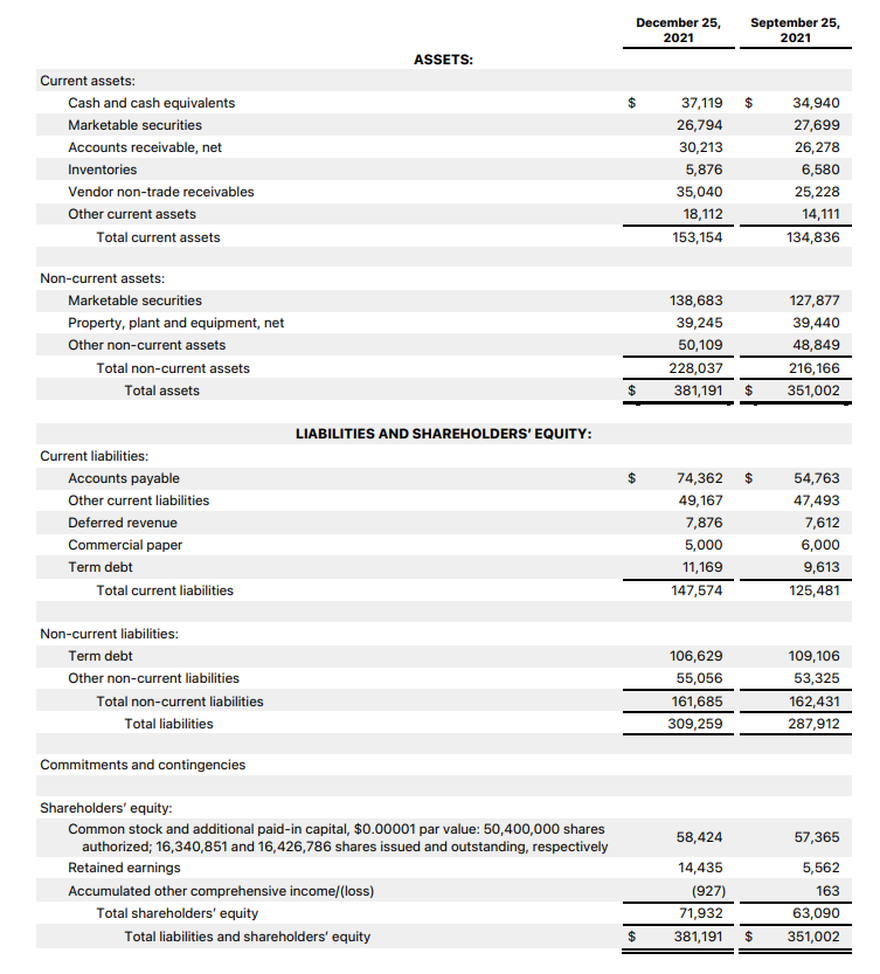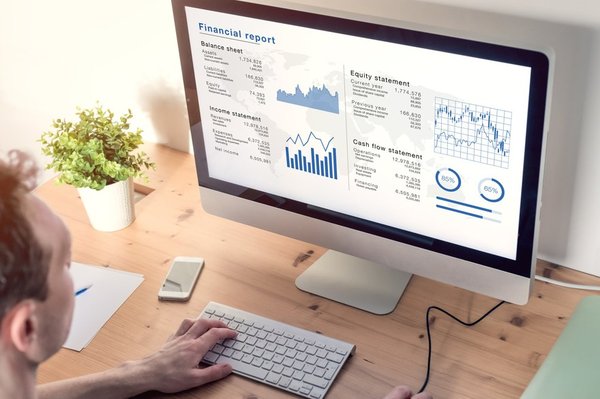Every publicly traded company issues a series of financial statements at least on a quarterly basis, and the balance sheet is perhaps the statement most indicative of a company's financial health.
A company's balance sheet contains important information about how much money it has, how much it owes, and more. In this article, we'll discuss the basics of balance sheets, how they work, what to focus on as an investor, and a real-world example of a balance sheet.

How balance sheets work
A balance sheet is a financial statement that shows the current financial state of a business and calculates the book value, or investors' equity, in the company. There are three main components of a balance sheet -- assets, liabilities, and shareholders' equity -- and we'll get into what information each one contains in the next section.
Balance sheets are important for investors to read because they can answer some very important questions about a company's financial health and financial flexibility. By knowing how to read a company's balance sheet, you can find the answers to questions such as these:
- How much cash does the company have available to make acquisitions or invest in growth?
- How much tangible property, such as factories and machinery, does the company own?
- How much debt does the company have?
- What is the actual book value of the company?
The balance sheet formula
Although a balance sheet itself can be quite complex and difficult to understand for many investors, the central concept is rather simple:

Rearranging this equation a bit shows that assets minus liabilities equals shareholders' equity. Also known as a company's book value, shareholders' equity can be thought of as the theoretical amount investors would have if a company closed its doors, sold off its assets, and paid its debts. Obviously, a large company wouldn't be very likely to do that, but the idea is similar to how home equity works -- if your home's value is more than what you owe the bank, you have positive equity.
Elements of a balance sheet
As previously mentioned, there are three main parts of a balance sheet -- assets, liabilities, and shareholders' equity. Let's take these one at a time.
Assets: The short explanation is that "assets" include everything a company owns. Assets are typically broken down into current and non-current assets. Current assets include liquid assets, such as cash and short-term investments. They also include assets that are expected to become liquid within a year, such as inventory and accounts receivable.
Non-current assets include things that won't be able to be readily spent within the next year. Tangible property, such as a factory, is the most obvious example, but this also includes equipment, long-term investments, and intellectual property.
Liabilities: Most notably, the liabilities category includes a company's debts. Like assets, liabilities are separated into current liabilities (those due within a year) and non-current liabilities. Debts coming due soon and accounts payable are examples of current liabilities you'll typically find on a balance sheet, while long-term debt is the most common type of non-current liability.
Shareholders' equity: Subtracting the company's liabilities from its assets shows its shareholders' equity. The metric itself is most useful when evaluating value investments as opposed to growth stocks since it shows what a business is "worth" simply due to what it owns and owes without any regard to its income-generating or growth potential.
It's also worth mentioning that shareholders' equity and a company's market capitalization (the market value of its stock) are often very different numbers, especially if a company can generate high returns on its assets or if it is growing rapidly.
Example of a balance sheet
Let's look at a real-world example of a balance sheet and how to read it. Here's a shot of Apple's (NASDAQ:AAPL) balance sheet as things stood on Dec. 25, 2021:

Assets
Let's start with the assets section. When you hear that a company "has a lot of cash," it usually isn't actually holding all of it in cash. The "cash and equivalents" category on the balance sheet contains actual cash as well as instruments like money market accounts. However, there's also the "marketable securities" categories in both the current and non-current assets categories that contain things such as Treasury securities, bond investments, and stocks. The key point is that these can typically be readily converted into cash the company can use. So, while Apple has roughly $37 billion in actual cash and equivalents, this figure swells to more than $202 billion when considering marketable securities.
Second, it's important to realize that, aside from cash and marketable securities, other values listed in the assets section aren't set in stone. For example, there's no guarantee that Apple could actually sell its property, plant, and equipment holdings for the $39.2 billion listed. Furthermore, the $5.88 billion in inventory listed assumes that it will all sell for full price, and the $30.2 billion in accounts receivable assumes that 100% of Apple's customers will pay their bills. And "other assets" is the vaguest of them all, which typically includes the value of things such as patents, goodwill, and other difficult-to-value items.
With that in mind, we can see that Apple has a total of about $382.2 billion in assets on its balance sheet.
Liabilities
The biggest liability on Apple's balance sheet is its long-term debt, which stands at about $106.6 billion. It also has a smaller amount of short-term debt, plus about $74.4 billion in accounts payable (such as to its part suppliers).
While Apple has more than $100 billion in current and non-current "other" liabilities -- and this is certainly a lot of money -- the key point to know is that this is a very broad category. On the current side, this can include things such as payroll obligations, accrued benefits, and other items due within a year. On the non-current side, liabilities can include lease obligations, deferred tax credits, customer deposits, and pension obligations, just to name a few.
In all, Apple has about $309.3 billion in liabilities reported on its balance sheet.
Shareholders' equity
When we take Apple's assets and subtract its liabilities, we see that its shareholders' equity is about $71.9 billion. As previously noted, think of this as the amount of money that would theoretically be left if Apple decided to cease business operations, sell everything it owns, and pay off its debts.
This is not a measure of how much the business is worth. Apple is a highly profitable and efficient business that is growing rather quickly even with its large size. In fact, Apple's market value is currently about $2.6 trillion -- about 36 times its shareholders' equity or book value.
Again, shareholders' equity is most useful when evaluating value stocks and for comparing the valuations of stocks in similar industries. For example, looking at the price-to-book value (P/B) ratio is especially useful when evaluating bank stocks since other common valuation metrics (like the price-to-earnings ratio) aren't always a great fit.
Related investing topics
How to create a balance sheet
If you own a small business or simply want to analyze your personal financial condition, a balance sheet can help you tremendously. You can start by listing your assets, including your cash, investments, accounts receivable (money you're owed), any inventory you own, property you have, etc. Then, make a list of all of the debts and other obligations you have. You can find some excellent balance sheet templates online that can help to keep you organized. Subtract the liabilities on your balance sheet from the assets to find the equity you have in your business or your personal net worth.
Balance Sheet FAQs
What's included in a balance sheet?
The three main components of a balance sheet are assets, liabilities, and shareholders' equity, although there are numerous subcategories of information within each of those. For example, the assets category contains information about the company's cash and property, and liabilities shows how much of different types of debt obligations a company has.
Why is a balance sheet important?
A balance sheet is important for several reasons, but mainly because it shows the financial health of a company. It also can be used to determine how much runway a growth stock has since it provides the amount of available cash. It also can reveal how the stock is valued relative to the company's book value.
How are balance sheets different from income statements?
The key difference between a balance sheet and an income statement is that a balance sheet shows a snapshot of a company's financial state at a given point in time, while an income statement shows how much revenue and income that a company generated during a given period.









